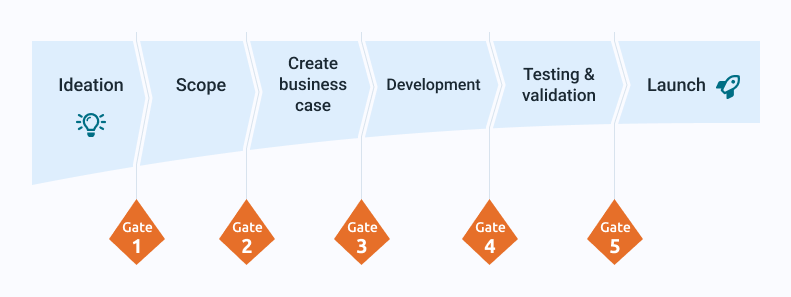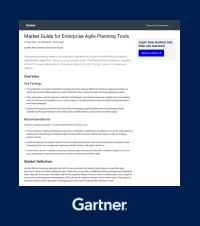Benefits of Stage Gate Process for Resource Management

The benefits of the Stage Gate Process for Resource Management are countless. Risk mitigation, higher project success rate, greater agility and flexibility in delivering results, customer involvement in the project development…
In our post “A comprehensive Guide of Phase-Gate Process for R&D projects” we explain in a general way how the Stage Gate methodology is our best ally for R&D projects and all the benefits that the implementation of this methodology will have for your projects.
And among these advantages is also a more efficient resource management. Would you like to know how the Stage Gate Process can be your best ally for the resource management of your project portfolio? In this article, we explain why you should adopt the Stage Gate methodology to manage your organization’s projects, programs and portfolios. And on the other hand, you will see how this process will help you to manage your organization’s resources and capacity planning more efficiently.
Benefits of Stage Gate methodology in Project Portfolio Management
Project portfolio management has dramatically changed over the last 15 years. The digital age and new technologies make our environment evolve faster. This forces companies to embark on high-risk projects, such as those related to R&D and new product development, in order not to lose competitiveness and market share. And all this to meet the needs of customers who increasingly demand technologically sophisticated products that are more and more tailored to their needs.
These are projects with a high degree of uncertainty, which in many cases involve the development of technologies about which little or no knowledge is available. There is also some uncertainty about project requirements in the early stages of the project, and about how the product will be received in the markets. Indeed, consumer needs change so fast these days that bad foresight and an incorrect implementation of the product in the markets can compromise the viability and credibility of the company in the short, medium and long term.
Stage Gate methodology offers mechanisms to manage the high degree of uncertainty of R&D projects
See the Triskell platform in action in a personal demo
The Stage Gate methodology offers precisely the mechanisms to better manage this high degree of uncertainty throughout all phases of the project life cycle. Its exhaustive review processes throughout all phases of the project, whether in R&D or any other field, are the best guarantee that the project does not derail prematurely and that it is aligned at all times with the strategic objectives of the organization.
These are the main benefits of the Stage Gate Process to manage your organization’s projects, programs and portfolios:
- Phase-Gates provides a clear and structured process.
- Agility to respond to strategic changes.
- Adaptable to Agile and non-Agile projects.
- Methodology easy to adopt.
- Methodology easy to adopt.
1. Stage-Gate provides a clear and structured process
If there is one thing that defines the Stage-Gate process, it is that it has a fully defined and structured framework. Review processes, also called Phases or Stages, are interspersed throughout all phases of the project life cycle (ideation, scoping, business case, development, testing and launch). At these events, after analyzing the progress made and comparing it with the Project Plan and the breakdown of specifications and requirements of the project, one of these decisions is made:
- To give the green light for the project to move forward to the next phase.
- To cancel the project.
- Put it on hold to prioritize other initiatives that are more important to the organization.
- Recycle the project, i.e. leave the project at the current phase to carry out the necessary improvements and optimizations to enable it to move on to the next phase.
It’s a methodology that has had hardly any changes in the last 35 years
It is a process that has been firmly established since this methodology began to take its first steps in the mid-1980s. However, it is a fact that, after the emergence of Agile methodologies, certain elements of Scrum have been incorporated into the process (such as the inclusion of 2 or 4-week iterations). These modifications have allowed the projects to gain speed throughout their different phases. But otherwise, it is a framework that has hardly experienced any changes since its implementation.

2. Agility to respond to strategic changes
For efficient project portfolio management, it is necessary that the portfolio is aligned with the strategic objectives of the business. These changes in strategy often lead to adjustments in project prioritization, resource allocation or budgeting. Many organizations are not able to respond effectively to these changes because they do not have mechanisms and processes in place to regularly review the alignment of strategy and execution.
Stage Gate and its phase-to-phase review processes are the perfect mechanisms by which to align project objectives and requirements to the organization’s mission and vision. In these review processes you can, for example:
- Review the requirements and objectives of a project in order to align them with the corporate strategy.
- Increase resources and budgets for a project or program if they are business-critical.
- Cancel a project or program if its objectives no longer match those of the company.
- Put a project on hold to prioritize other projects or programs that better fit the new strategic objectives.
3. Adaptable to Agile and non-Agile projects
Although the Stage Gate Processes are better suited to R&D and new product development projects because of the uncertainty surrounding these types of initiatives, actually it can be adapted to any type of project or program.
Review processes act as decision-making enablers
The review processes so distinctive of this methodology also serve as decision enablers in some of the most important aspects of project portfolio management. Hence, Stage Gate is applicable to any kind of project. Some examples of decision-making facilitated by the Phase Gate Process:
- Align each project and program to the strategic objectives of the business, as mentioned in the previous point.
- Prioritize each project according to its requirements and the company’s mission and vision.
- Manage the organization’s resources and capacity planning in accordance with the priority and requirements of each project.
- Allocate more budget and funds to those projects that are most important to the business.
- Increase or reduce costs depending on project requirements and priority.
4. Methodology easy to adopt
Resistance to change is the main reason why enterprises delay the implementation of new frameworks. Now, this resistance is more difficult to occur if you decide to implement the Stage Gate methodology in your company.
It is a very easy process to understand and assimilate since it is a methodology that does not require a complex vocabulary. Ultimately, it is a methodology that reflects how many PMO leaders or project managers work on a day-to-day basis: reviewing every few gels of work done to assess the quality of the work and how it can be improved.
Stage-Gate can be adapted to a wide variety of situations, from large research and development projects to small-scale projects. Also, it does not matter the sector to which the corporation belongs, because although in its beginnings the Stage-Gate methodology was more linked to companies linked to the Energy sector, this process is adaptable to any project in any sector (engineering, automotive, electronics, software, banking, etc.)
5. Risk mitigation
With the Stage Gate processes, you can naturally mitigate the risks of any project or program. This is because through the review process between phases you will achieve the following:
- Keep all project or program stakeholders aligned on the project requirements and objectives to be achieved.
- No project steps will be skipped. By having to review the progress made in each phase you ensure that all deliverables have been satisfactorily completed before you can move on to the next phase of the project.
- Align the project to the strategic objectives of the business throughout its entire life cycle, and make the necessary adjustments so that the project does not lose its way with regards to the business strategy.
Today, project portfolio management lives in a constant state of uncertainty, especially when it comes to aligning project execution with strategic objectives. Therefore, having a framework that allows you to review progress from time to time, and that is easy to understand and implement, will ensure that Stage Gate has a high degree of acceptance in your company.
Benefits of Stage-Gate Process for Resource Management
Budget management, financial management, risk management, stakeholder management…If you decide to implement the Stage-Gate methodology in the processes you already have in place for project portfolio management in your organization, the results you will obtain will be almost immediate.
However, if there is one aspect of portfolio management that will be improving, it will undoubtedly be resource management. You will be able to adjust and plan resources according to the conclusions you obtain in each of the review processes the project goes through. You’ll gain happier, more productive teams focused on delivering value.
These are the main benefits of Stage-Gate Process for your existing resource management processes:
- What-if scenario analysis enabler.
- Focus on continuous value delivery.
- Resource allocation according to portfolio needs.
- Increased productivity.
- Higher project teams satisfaction.
1. What-if scenario analysis enabler
What-if scenario analysis and planning are key for project portfolio management in any corporation. It enables resource allocation and capacity planning of the organization based on short-, medium- and long-term demand.
What-if scenario analysis and planning is key for project portfolio management
Phase-Gate review processes naturally act as process enablers for planning and analyzing future scenarios that a project may go through. As it is a process in which it is decided whether or not a project or product under development moves to the next phase, this indirectly enables processes for the allocation of resources depending on the scenario in which the project is located. For example:
- As the project moves from phase to phase, the review process can be used to list the resources that will be needed for the next phase.
- If the project requirements change, this may require the acquisition of certain profiles that the organization does not have.
- On contrary, if the project is recycled, it may be an opportunity to allocate more resources to the project in order to correct the errors and bring the project back on track.
- If the project is cancelled or put on hold, all those resources can be reallocated to other projects in the portfolio.
2. Focus on continuous value delivery
With the Phase-gate methodology, resource management will be focused on continuous value delivery throughout the entire project lifecycle…Stakeholders, project managers, teams… all of them must be aligned on the requirements and milestones to be achieved in each phase of the project, and which are agreed upon in each of the project reviews.
At the same time, these requirements and milestones must be aligned with the organization’s strategic objectives. Therefore, everyone involved in the project will know at all phases what is expected of each of them, and their work will result in delivering value not only to the project, but also to the business.
Project requirements and milestones must be aligned with the strategic objectives
3. Resource allocation according to portfolio needs
Phased reviews allow capacity planning of the organization based on the status of the projects. Thus, if a project is cancelled or put on hold, all the resources that were working on that initiative can be assigned to others that may be in progress. Or, on the other hand, more resources can be allocated or sourced depending on the project requirements.
In this way, you will align resource management with the priority of the different deliverables. You will avoid problems such as over-allocation of resources to projects with low business value, and you will also ensure that each initiative has the right number of resources allocated to it.
4. Increased productivity
Once you design and implement processes focused on allocations based on the needs of your project portfolio, the productivity of your teams will increase exponentially.
Project managers, Product Owners, departments, development teams…Thanks to the review processes of the Stage-Gate Methodology, your decision making when managing resources will be focused on the productivity of your teams:
- Plan in advance the overall resources required for each phase of the project.
- You will be able to better estimate the total hours that each resource needs to dedicate to the project.
- You will assign objectives and KPIs to each team involved in the project in an evidence-based manner.
- The value contributed by each resource to the final result of the project will be tangible for each of them.
5. Higher project teams satisfaction
Finally, and following up on what was mentioned in the previous point, since the teams will become aware of the value they are contributing to the project throughout its life cycle, this will result in having more motivated people and teams. And you know what this means:
- Good working environment.
- Team collaboration takes the lead over silos.
- Motivated staff=higher project success rates.
- Lower employee rotation and departures from companies.
Conclusion
Resource management is one of the most complicated aspects you will have to deal with when managing the project portfolio of your organization. Many companies fail to align resource allocation and capacity planning because they do not have the right processes and methodology to do so.
The Stage Gate methodology, however, allows this process to be modulated in a natural way. Throughout the review process, you will be able to plan capacity and allocate resources based on the objectives and requirements of each phase of the project, without ever losing sight of the company’s strategic objectives.
To help you with its management, it is also essential to have a PPM tool such as Triskell Software that allows you to handle all aspects related to resource management (capacity planning, resource allocation, timesheeting, What-if scenarios, etc.) efficiently and in real-time.
Subscribe to our Newsletter
Get stories like this in your inbox
Request a demo of Triskell Software
Would you like to know how Triskell Software can help you with resource management in your organization while applying the Phase-Gate methodology?

FAQs about benefits of Stage-Gate
What are the core benefits of the Phase-Gate process?
The Stage-Gate process offers several advantages, including:
- Reduced Risk: Stage-Gates act as checkpoints, allowing for early identification and mitigation of potential issues before significant resources are invested.
- Improved Resource Management: By focusing on promising projects at each gate review, resources aren’t wasted on ideas unlikely to succeed.
- Increased Success Rate: Structured decision-making and clear go/no-go points at gates help ensure projects with the highest potential for success are prioritized.
- Enhanced Agility: The Stage-Gate process can be flexible and adaptable to different project types and organizational structures.
Is the Stage-Gate process compatible with Agile methodologies?
Yes, the Stage-Gate process can be adapted to complement Agile methodologies. By incorporating elements like the Triple A Process (Agile, Acceleration, Adaptive), you can achieve faster project delivery while maintaining the core benefits of Phase-Gates.
How can the Stage-Gate process benefit R&D projects specifically?
For R&D projects, Stage-Gate provide a structured approach to managing innovation. They enable early identification of promising ideas, facilitate efficient resource allocation for R&D efforts, and increase the likelihood of successful product development.
How does the Stage-Gate process contribute to better project decision-making?
Stage-Gate enforces structured reviews with clear criteria for project evaluation. This data-driven approach reduces bias and fosters objective decision-making regarding project continuation, resource allocation, or potential termination.
Related Content

Why the CIO needs a PMO approach
Unlock business success: discover why the CIO must embrace a PMO approach! to elevate efficiency and boost productivity.

Lean Budgeting for Agile Portfolios: A Comprehensive Guide
Lean Budgeting: the financial revolution for Agile portfolios. Discover how to streamline project financing and optimize value delivery.

Implementing SAFe with a 7-step roadmap
Do you want to scale Agile at the enterprise level and don’t know where to start? We solve your doubts by explaining the steps to implement SAFe.

